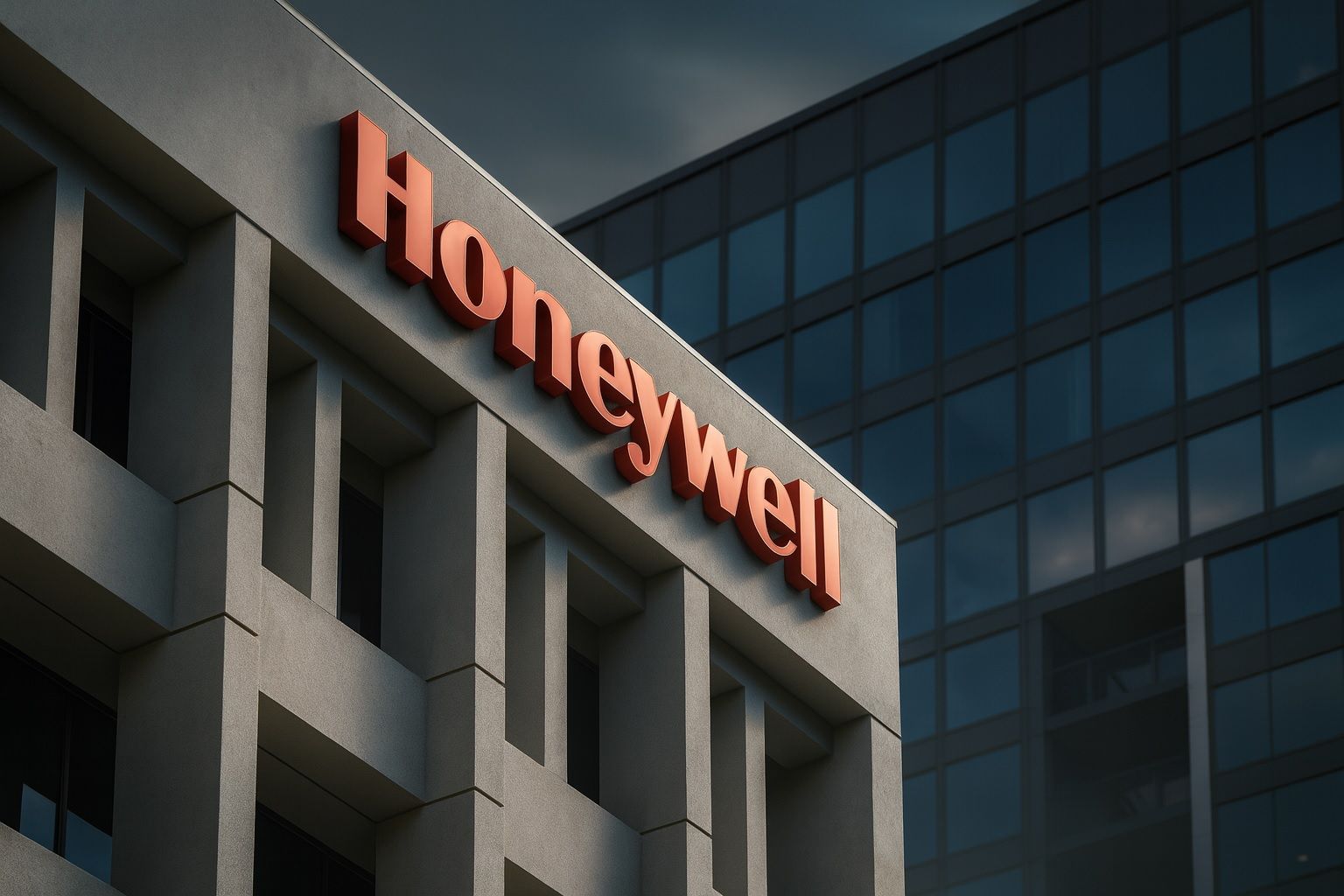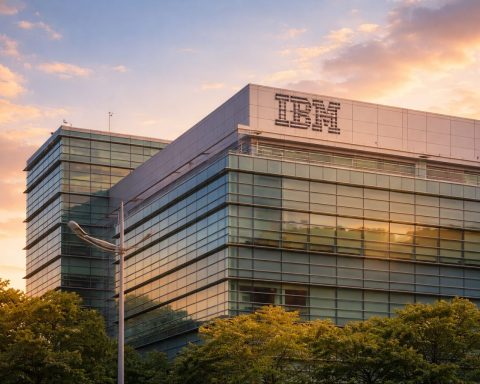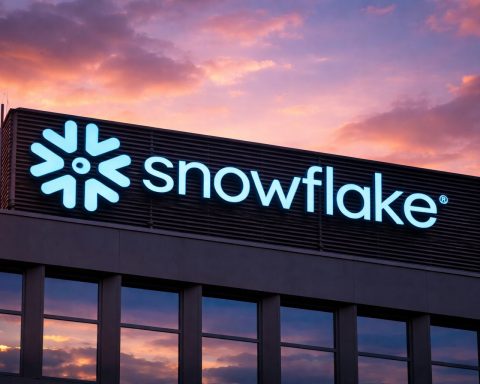- Strong Post-Earnings Rally: Honeywell International (NASDAQ: HON) stock surged nearly 5% in pre-market trading on October 23, 2025 after the company beat Q3 earnings estimates and raised its full-year outlook [1]. Shares hovered around $218 by mid-day, trimming the stock’s year-to-date decline to roughly 3.6% [2].
- Q3 Earnings Beat:Third-quarter sales jumped 7% to $10.41 billion, topping analysts’ $10.14 billion estimate, while adjusted EPS of $2.82 beat forecasts of $2.57 [3]. Honeywell cited booming aerospace demand for the upbeat results.
- Guidance Raised: Honeywell hiked its 2025 profit forecast, now projecting full-year adjusted EPS of $10.60–$10.70 (up from $10.24–$10.44 prior). This revised guidance, which factors in an upcoming spin-off, signals robust momentum into year-end [4].
- Aerospace Strength, Automation Weakness: The aerospace division (≈40% of revenue) is powering growth – Q3 aerospace sales rose 15% to $4.51 billion amid booming new jet demand [5] [6]. In contrast, the smaller automation segment saw sales fall 9% as higher costs and softer industrial demand weighed on results [7].
- Breakup in Progress: Under pressure from activist Elliott Management, Honeywell is splitting into three companies by 2026. It will spin off its advanced materials unit (“Solstice”) on Oct. 30, 2025 and carve out the aerospace business in 2H 2026 [8] [9]. The remaining Honeywell will focus on automation technologies.
- Analyst & Expert Views: Wall Street’s stance is bullish – about 13 Buy vs 11 Hold ratings and a $250 median price target (~20% above current) for HON [10]. “We continue to believe the separation makes strategic sense… however, our sum-of-the-parts valuation points to little near-term upside,” cautioned RBC Capital analyst Deane Dray [11]. A quantitative model on TS2 also gave Honeywell a 68% score (out of 100) – indicating “potential interest but not a strong buy signal” under a conservative low-volatility strategy [12].
Honeywell Stock Jumps on Earnings Beat
Honeywell’s third-quarter report arrived as a positive surprise for investors. The industrial-tech conglomerate beat Wall Street expectations on both revenue and profit, and management struck an upbeat tone by raising full-year guidance. Quarterly sales reached $10.41 billion (up 7% year-on-year), topping analysts’ $10.14 billion forecast, according to LSEG data [13]. Adjusted earnings of $2.82 per share easily surpassed the $2.57 consensus [14]. These stronger-than-expected results immediately boosted market sentiment. In pre-market trading on Oct. 23, Honeywell’s stock spiked nearly 5% [15]. By midday, HON hovered around $218 per share, roughly 6% higher than the prior close, and narrowing its year-to-date loss to about 3.6%. This relief rally suggests investors welcomed the earnings beat and guidance hike after a choppy year for the stock [16] [17].
Management raised its full-year outlook, signaling confidence in sustained demand. Honeywell now forecasts 2025 adjusted earnings of $10.60–$10.70 per share, up from a $10.24–$10.44 range earlier [18]. (Notably, that guidance is adjusted for the upcoming spin-off of the Solstice materials unit, which will slightly reduce earnings.) The improved forecast implies Honeywell expects a strong finish to 2025. “Honeywell on Thursday raised its 2025 profit forecast despite the impact of a planned separation… signaling robust growth prospects fueled by strong aerospace demand,” Reuters reported, noting the news sent HON shares sharply higher [19].
Investors will also appreciate that Honeywell modestly raised its full-year sales outlook to ~$40.8 billion (midpoint), from about $40.5 billion prior (also accounting for the spin-off) [20]. This suggests broad-based strength, even as certain segments face headwinds. The company’s ability to beat Q3 expectations and lift guidance in the face of a slowing economy has bolstered confidence. “Honeywell now expects full-year adjusted EPS between $10.60 and $10.70… It previously expected $10.24 to $10.44,” Reuters noted of the revised outlook [21].
Aerospace Boom Drives Results
A surge in aerospace demand is the clear growth engine for Honeywell right now. The company’s Aerospace segment – its largest division, producing aircraft engines, avionics, and parts – grew 15% year-over-year to $4.51 billion in Q3, beating internal plans [22]. Honeywell credited robust demand from planemakers ramping up jet production and improving supply chains for electronics [23] [24]. Aerospace suppliers globally have benefited as Boeing and Airbus boost output to meet airlines’ appetite for new jets. Honeywell’s CEO Vimal Kapur highlighted that even maintenance and repair services are seeing tailwinds, since an ongoing shortage of new jets means airlines must keep older planes flying longer (which requires more Honeywell parts and services) [25] [26]. In short, civil aviation’s post-pandemic upcycle is lifting Honeywell’s fortunes.
Recent industry data underscore this trend. Earlier this month, Honeywell’s own annual Business Aviation Outlook projected 8,500 new business jet deliveries worth $283 billion over the next decade – a record high [27] [28]. “More people are flying in business aviation than pre-COVID,” noted Honeywell Aerospace’s strategy chief, citing resilient private jet demand [29]. This bodes well for Honeywell’s avionics and jet engine units. The company expects new business jet deliveries to grow ~5% in 2026, and sees sustained demand despite macroeconomic and geopolitical uncertainties [30]. Such bullish aerospace forecasts, combined with easing supply bottlenecks for key components [31], help explain Honeywell’s strong Q3 and confidence going forward.
By contrast, Honeywell’s Performance Materials and Technologies (automation and industrial segment) is struggling with softer demand. In Q3, sales in its building automation, warehouse solutions, and productivity businesses fell 9% to $2.27 billion [32] [33]. Higher costs and an e-commerce slowdown have hurt this segment. Management acknowledged the industrial automation unit has been “a drag on results of late.” Now, with aerospace booming and automation cooling, Honeywell’s planned breakup (detailed below) will allow investors to value these businesses separately. For now, the red-hot aerospace tailwinds are more than offsetting the weaker segment in Honeywell’s consolidated results.
Recent News: Spin-Offs and Strategy Shifts
Honeywell is in the midst of a historic transformation. After over a century as a diversified conglomerate, the company is breaking itself apart – a move aimed at unlocking value and sharpening each unit’s focus. In February 2025, Honeywell announced plans to split into three independent companies, shortly after activist hedge fund Elliott Management took a $5+ billion stake and pressed for a breakup [34] [35]. This will mark the end of Honeywell as a one-stop industrial conglomerate, following a path blazed by peers. “With Honeywell’s decision, the ranks of the nation’s leading industrial conglomerates have dwindled even further, following similar choices in recent years by 3M, General Electric and United Technologies to split off major divisions,” Reuters observed [36]. Indeed, GE has carved out its healthcare and energy businesses, while 3M is working to spin off its healthcare unit – all part of a broader trend of giants streamlining their empires.
For Honeywell, the breakup involves three pieces: (1) Aerospace Technologies (the aviation systems and engines business), (2) Honeywell Building Automation (focused on building controls, safety and productivity solutions), and (3) Advanced Materials (Solstice), which includes specialty chemicals and materials. The first step happens this month: Honeywell will spin off the Solstice Advanced Materials division on October 30, 2025, creating a new publicly traded company [37]. Each Honeywell shareholder will receive shares in Solstice, and the unit will trade on Nasdaq. Next, Honeywell plans to separate the Aerospace unit by the second half of 2026 [38] [39]. The remaining company (often dubbed “Honeywell RemainCo”) will be centered on automation and building technologies, led by current CEO Vimal Kapur [40] [41].
Just one day before its Q3 earnings, Honeywell announced an updated business segment structure to prepare for this new era. Beginning Q1 2026 (after the aerospace spin), Honeywell’s financial reporting will be realigned into three segments: Aerospace Technologies, Building Automation, and Energy & Sustainability Solutions, replacing the old four-segment model [42]. This realignment foreshadows how the post-breakup Honeywell will focus on specific end markets. It also confirms that the aerospace spin-off is on track, with leadership teams and structures falling into place. In fact, Honeywell disclosed that each spin-off will have its own management – for example, the Building Automation business will be led by a dedicated CEO (Billal Hammoud) once separated [43]. These moves show Honeywell proactively readying the organizations for independence.
The strategic rationale behind the breakup is to create nimbler, more focused companies that can pursue growth in their domains – much like GE’s breakup aimed to let its aviation unit shine separately. Honeywell’s board and activists believe the parts may be worth more than the whole. For instance, analysts had valued Honeywell’s high-margin aerospace segment at $90–$120 billion on its own [44], which could imply upside given Honeywell’s total market cap was around $130 billion pre-split. At an industry conference, CEO Kapur noted that having standalone entities allows each business to adopt tailored capital structures and strategies for its industry [45]. “The thesis that separation brings more focus clearly is valid… each company is now programmed for its own future with its own management team,” Kapur explained [46]. He also highlighted exciting opportunities in the automation business – from cloud connectivity to industrial AI – that he can now “spruce up” once it’s an independent firm [47].
It’s worth noting that activist Elliott’s push came after Honeywell’s stock underperformed in 2024. Elliott argued Honeywell’s diverse portfolio was undervalued and that a split could boost the share price by 50–75% over two years [48]. (Elliott’s stake is one of its largest ever in a single company.) Honeywell had resisted such pressure before – famously fending off a breakup campaign by Third Point in 2017 [49] – but the industrial giant finally embraced the split amid this latest activist campaign. As of now, investors appear cautiously optimistic that the plan will unlock value, though the real payoff will only become clear after the separations are executed in 2025–2026.
How Do Analysts View Honeywell?
Wall Street analysts have generally welcomed Honeywell’s latest results and strategic moves, while urging some patience. The consensus is bullish but not euphoric. According to a survey of 27 analysts, the stock carries a “Strong Buy” consensus (roughly split into 13 Buys, 11 Holds, 0 Sells) and the median 12-month price target is about $250 [50]. That implies ~20% upside from the current ~$208–$218 trading range. Price targets range from a low of ~$210 to a high near $290 [51] [52], reflecting differing views on how much value the breakup and earnings growth will unlock. Notably, even some typically cautious voices (like Morgan Stanley’s equal-weight rating) still peg Honeywell’s worth around the current price or higher [53]. This suggests limited downside seen by most analysts at this point, barring a macro downturn.
Several experts highlight aerospace momentum and the spin-off catalyst as reasons to be optimistic. “I think having more focus is never a bad thing,” said Bombardier CEO Éric Martel, applauding Honeywell’s decision to separate aerospace into a dedicated company [54]. Honeywell is a key supplier to Bombardier jets, and Martel believes an independent Honeywell Aerospace will be “very significant” in that market [55]. Financial analysts agree that Honeywell’s aviation unit is a crown jewel; some estimate it could command a premium valuation given its strong margins (Honeywell’s aerospace division posted a 25% profit margin last quarter) [56] [57]. There’s also enthusiasm for Honeywell’s exposure to secular trends like urban air mobility, defense modernization, and sustainability – areas it can focus on more intently after the split.
However, analysts also temper expectations on immediate gains. RBC Capital Markets analyst Deane Dray wrote that while the breakup “makes strategic sense,” Honeywell’s current valuation already reflects a lot of good news. His “sum-of-the-parts valuation points to little near-term upside” to the stock [58], implying investors may need to wait for the spin-offs to be completed (and perform) before realizing significant value. This cautious take was echoed by some others who worry that if Honeywell’s 2026 outlook (post-breakup) only modestly tops current estimates, the market may react coolly [59]. In other words, the bar is rising now that Honeywell has rallied off its lows and promised big things from the reorganization.
From a quantitative perspective, one recent analysis gave Honeywell a lukewarm score. According to a Validea multi-factor model highlighted on TS2, Honeywell scored 68% under a conservative “low-volatility, high-payout” stock strategy [60]. This indicates “some interest but not strong conviction” in HON as an investment, given mixed momentum and dividend signals [61]. (By comparison, stocks scoring above 90% in that model are considered very attractive.) The model’s neutral rating aligns with the view that Honeywell is solid, but not a screaming bargain at current levels. Still, most analysts emphasize Honeywell’s quality franchises and improving outlook, advising long-term investors to stay the course. The company’s diverse end markets – spanning aerospace, energy, buildings, and chemicals – have historically provided resilience. As Honeywell transitions into its next chapter, how each new entity executes will determine if today’s optimistic forecasts pan out.
Outlook: Near-Term Catalysts and Long-Term Vision
In the immediate term, all eyes are on Honeywell’s upcoming catalysts. First, the Solstice Advanced Materials spin-off is set for October 30, 2025, which will formally separate that business and could prompt an adjustment in Honeywell’s stock price (as assets leave the parent company). Investors will receive one share of the new Solstice company for every 25 Honeywell shares owned, as per the distribution plan [62]. The spin-off will be tax-free to shareholders and should allow the market to independently value Solstice’s performance chemicals portfolio, which includes environmentally-friendlier refrigerants and specialty materials. While smaller than Honeywell’s core segments, Solstice could attract interest as a pure-play materials stock. Honeywell’s board set a record date of October 20 for determining eligible shareholders for the distribution [63]. Once Solstice begins trading on Nasdaq, Honeywell’s remaining business mix will shift more toward aerospace and industrial automation.
Next, the focus will turn to Honeywell’s Q4 and full-year 2025 results, due in late January or early February 2026. That will be the final earnings report of Honeywell in its current form, and management may provide more detailed 2026 guidance for each segment heading into the break-up. Investors will watch for any signs of slowing aerospace orders or further weakness in automation demand that could alter the bullish narrative. Thus far, trends look favorable – aircraft production backlogs extend for years, and Honeywell’s order backlog was up (the company reported double-digit backlog growth, indicating future revenue visibility [64]). Still, macro risks like higher interest rates or geopolitical shocks could impact airline capital spending or industrial activity, so Honeywell’s management will likely remain cautious in its commentary.
Looking longer term, Honeywell’s leadership argues that the breakup positions each new company to unlock growth opportunities. CEO Kapur – who will lead the automation-focused “RemainCo” – has been particularly upbeat about the prospects in industrial automation, digital transformation, and sustainability solutions. He noted that the “confluence of cloud, data, and AI” is creating a “way bigger” opportunity in automation than previously expected [65] [66]. By freeing the automation business from aerospace’s shadow, Kapur believes it can innovate faster in software, warehouse robotics, and smart buildings. Honeywell has been actively shuffling its portfolio to support this vision, selling non-core units and making acquisitions in targeted areas. In the past year, the company completed six acquisitions (four in automation, two in aerospace) to bolster its tech capabilities [67] – including moves into digital engineering and advanced warehouse automation. We may see more deal activity as each spin-off seeks to scale up (the aerospace unit, for instance, could pursue partnerships in defense or urban air mobility once independent).
For shareholders, the key question is whether the sum of Honeywell’s parts will indeed be worth more. Empirical data on spin-offs is mixed: RBC notes a basket of industrial spin-offs beat the market by ~27% in their first year [68], but not every case is a success. Management will need to ensure a smooth separation process and then deliver on performance targets for each new company. That said, Honeywell’s strong Q3 results and raised guidance show the core businesses have momentum heading into this transition. The aerospace unit’s growth looks sustainable given industry tailwinds, and the automation unit, while currently lagging, could rebound if industrial capex picks up or new efficiency products gain traction. Honeywell’s dividend (currently yielding around 2.7%) remains well-supported through the changes, and each new company is expected to continue paying dividends post-breakup, per management’s intent.
Bottom line: Honeywell’s stock is regaining favor after a period of stagnation, fueled by confidence in its aerospace upswing and breakup value creation. The stock’s nearly 5% pop on earnings day [69] reflects optimism that management is executing well. Investors should keep an eye on upcoming spin-off milestones and any macro shifts, but many analysts agree Honeywell is positioned attractively for the long run. “We think the separation makes strategic sense,” as RBC’s Deane Dray said, even if patience is required for the payoff [70]. With a streamlined trio of businesses, Honeywell aims to join the likes of GE in proving that sometimes, smaller and focused is better. The next few quarters – and the market’s reception of the new Honeywell entities – will ultimately reveal how much upside remains as this industrial icon reinvents itself.
Sources: Honeywell Q3 earnings and guidance (Reuters) [71] [72]; Stock price reaction (Reuters/MarketScreener) [73] [74]; Aerospace demand outlook (Reuters) [75] [76]; Break-up plans and activist pressure (Reuters) [77] [78]; Analyst commentary (Reuters/TS2/TickerNerd) [79] [80] [81].
References
1. www.investing.com, 2. www.marketscreener.com, 3. www.investing.com, 4. www.investing.com, 5. www.investing.com, 6. www.investing.com, 7. www.investing.com, 8. www.investing.com, 9. www.reuters.com, 10. tickernerd.com, 11. www.reuters.com, 12. ts2.tech, 13. www.investing.com, 14. www.investing.com, 15. www.investing.com, 16. www.investing.com, 17. www.marketscreener.com, 18. www.investing.com, 19. www.investing.com, 20. www.marketscreener.com, 21. www.investing.com, 22. www.investing.com, 23. www.investing.com, 24. www.reuters.com, 25. www.investing.com, 26. www.investing.com, 27. www.reuters.com, 28. www.reuters.com, 29. www.reuters.com, 30. ts2.tech, 31. www.reuters.com, 32. www.investing.com, 33. www.investing.com, 34. www.reuters.com, 35. www.reuters.com, 36. www.reuters.com, 37. www.investing.com, 38. www.investing.com, 39. www.reuters.com, 40. www.investing.com, 41. www.investing.com, 42. www.honeywell.com, 43. www.tradingview.com, 44. www.reuters.com, 45. www.investing.com, 46. www.investing.com, 47. www.investing.com, 48. www.reuters.com, 49. www.reuters.com, 50. tickernerd.com, 51. tickernerd.com, 52. tickernerd.com, 53. tickernerd.com, 54. www.reuters.com, 55. www.reuters.com, 56. www.reuters.com, 57. www.reuters.com, 58. www.reuters.com, 59. www.bloomberg.com, 60. ts2.tech, 61. ts2.tech, 62. www.honeywell.com, 63. www.honeywell.com, 64. www.investing.com, 65. www.investing.com, 66. www.investing.com, 67. www.investing.com, 68. www.reuters.com, 69. www.investing.com, 70. www.reuters.com, 71. www.investing.com, 72. www.investing.com, 73. www.investing.com, 74. www.marketscreener.com, 75. www.reuters.com, 76. www.investing.com, 77. www.reuters.com, 78. www.reuters.com, 79. www.reuters.com, 80. ts2.tech, 81. tickernerd.com









